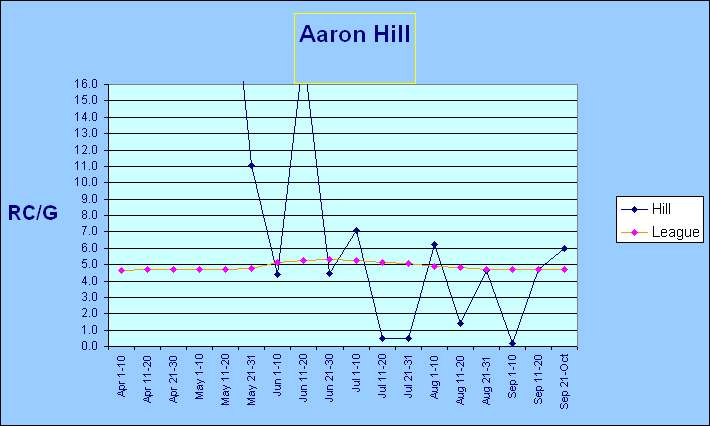
THere is another installment in what will surely turn out be a multi-part series: let's think of it as a Post-Mortem Analysis of the 2005 Blue Jays.
One of the things I intend to do is produce full season versions of many of the Data Tables I threw together on the fly at various points during the season. This one is about the bats.
We all anticipated trouble with the bats. The Blue Jays scored just 719 runs in 2004, and then watched and wept as the greatest hitter in franchise history left town as a free agent. The Blue Jays Roundtable Preview prophesied trouble ahead. To wit:
Dave Till: They'll have trouble scoring enough runs.
Jordan: The offence just won't be there.
Gerry: I am concerned about the offense, will it score enough?
Magpie: 79-83. Sorry, they just won't score quite enough runs.
I thought it possible, however, that the Blue Jays could reduce their runs allowed - 823 in 2004 - by about 60. Just giving all of Pat Hentgen's innings to Roy Halladay ought to do the trick. In fact, in a giddy fit of optimism called And I Have a Dream Today, I actually wrote:
if everything breaks right, the Jays can cut their runs allowed into the 730-750 range. An enormous IF, I grant you. A dream, perhaps.
If this happened, and the offense stayed at the same 2004 level of 4.45 runs per game, the Jays would probably win 78-80 games. To get beyond that and into actual contention for a post-season berth would require roughly a 100 run improvement from the offense. So my bright idea was this: How about if every spot in the lineup, plus the bench, is 10 runs better than last year. Is that feasible?
What do I know? It just seemed so remote that the Jays could actually reduce their runs allowed by 70 to 90. And they didn't. Despite Roy Halladay making just 19 starts, the 2005 cut their runs allowed by 118, from 823 to 705. The only appropriate response to that is "Wow."
Did they get the 100 more runs scored that I thought they would need? No - they scored 56 more runs in 2005. Granted, with the totally unforeseen improvement in the run prevention department, this actually should have been enough to propel them at least into the 86 win range. And we'll be talking some more over the winter about just how it came to pass that the Jays scored 70 more runs than they gave up, and still lost more games than they won.
But this is about the bats. I was hoping that the chance of squeezing an extra 10 runs of offense from each position was - well, not exactly impossible. So how did it all shake out? Here comes the Data Table: AL offensive production by lineup position, sorted, as always when I do the heavy lifting, by Runs Created per Game.
There is a sensible objection, by the way, to this sort of analysis. Nobody goes to bat as a defensive player - everybody is just a hitter. By the standards of AL first baseman, Eric Hinske is not one of the best hitters around. Even I, the Dude's Advocate, will not quarrel with that assessment. However, Hinske really is one of the better hitters available to the Toronto Blue Jays - I will brook no argument on this issue - so you'd better get him in the lineup if you can.
However, while looking at production by defensive position may be irrelevant at the game level, it is surely relevant at the roster-building level. Most of the available bats tend to cluster at the far end of the defensive spectrum. If you're having trouble scoring runs because you have a black hole soaking up at bats in the middle infield - that's a hard problem to solve. But if you're getting lousy production from your DH or first baseman, that's good news by comparison. It's an easier hole to fill.
Anyway, the Raw Numbers. Scoring was down in the AL this year, from just over 5 runs per game in 2004 to about 4.75. Normally, offense increases as the weather warms up. This was happening in 2005, when in August, for no apparent reason, league-wide offense suddenly began plungin towards April levels, and reached them in September.
Just for entertainment value, I'll include as well the full-season version of some pretty pictures I made in mid-season. These broke down the offensive performance of the Jays regular hitters into 10 day segments. The purpose at the time was to try to get a handle on who was streaky, who was slump-prone, who was consistent.
CATCHERS TEAM AB R H TB 2B 3B HR RBI BB SO SB CS SH SF HBP GDP AVG SLG OBP RC RC/27 Minnesota 582 72 182 252 38 1 10 81 58 80 13 1 2 3 4 19 .313 .433 .376 90 6.09 Cleveland 613 78 179 276 37 0 20 86 70 86 0 1 1 8 5 17 .292 .450 .364 95 5.91 Boston 597 84 157 277 37 1 27 82 72 165 4 0 1 3 6 11 .263 .464 .346 93 5.69 Texas 575 69 147 243 33 0 21 76 33 88 0 0 7 3 7 10 .256 .423 .299 70 4.44 Baltimore 578 66 150 252 25 1 25 76 26 113 0 1 2 4 11 23 .260 .436 .301 67 4.23 AVERAGE 585 69 151 231 29 1 16 72 45 101 3 2 3 4 7 17 .258 .395 .315 67 4.20 New York 578 75 137 226 26 0 21 78 65 114 0 0 2 5 3 12 .237 .391 .314 68 4.16 Chicago 601 79 153 247 29 0 22 67 30 90 0 4 3 1 13 18 .255 .411 .302 67 4.03 LA Angels 580 58 149 230 18 0 21 86 36 85 2 2 9 3 3 18 .257 .397 .298 63 3.96 Detroit 631 86 161 255 33 5 17 68 22 115 7 3 3 9 8 24 .255 .404 .284 65 3.71 Oakland 654 76 175 212 32 1 1 61 54 56 8 3 0 5 20 26 .268 .324 .340 66 3.70 Toronto 551 72 129 187 23 1 11 67 78 100 2 3 4 5 2 15 .234 .339 .327 58 3.68 KC 565 58 136 214 30 3 14 70 35 120 3 2 2 3 3 14 .241 .379 .286 57 3.57 Tampa Bay 558 42 145 197 28 0 8 57 30 81 0 1 3 7 6 21 .260 .353 .300 53 3.48 Seattle 525 54 113 164 21 0 10 46 24 124 1 3 8 2 3 14 .215 .312 .249 37 2.44
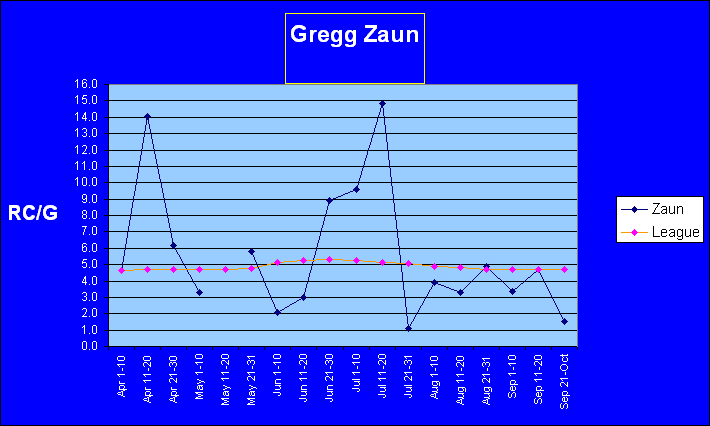
The young guns are taking over - Joe Mauer and Victor Martinez are emerging as the class of the league. I thought the Jays would see some improvement in 2005 simply because they wouldn't be giving some 180 at bats to Kevin Cash. The prospect of Ken Huckaby never even occurred to me. Gregg Zaun was very close to being a League Average offensive player this season (4.8 RC/G); this meant that he was a considerably better hiter than the average AL catcher. Unfortunately, the other Toronto catchers hit .183 in 126 at bats, which dragged the team's production well below the league average. And the chart demonstrates, graphically (!), what happened to Zaun's offense as the season went on. The lack of a practical alternative gave the skipper little choice but to play Zaun until he dropped. Or at least stopped hitting.
FIRST BASE TEAM AB R H TB 2B 3B HR RBI BB SO SB CS SH SF HBP GDP AVG SLG OBP RC RC/27 Texas 643 110 191 359 39 3 41 136 74 126 4 0 0 3 11 16 .297 .558 .378 129 7.71 New York 568 95 156 305 23 0 42 118 96 122 2 0 0 5 13 15 .275 .537 .389 113 7.42 Seattle 592 99 158 318 38 1 40 123 89 169 1 1 0 3 6 16 .267 .537 .367 110 6.81 Chicago 606 92 163 295 21 0 37 94 78 125 0 1 0 3 5 10 .269 .487 .355 101 6.14 Baltimore 577 78 169 254 23 1 20 80 65 63 3 1 6 9 3 14 .293 .440 .359 89 5.86 Boston 598 74 167 261 29 1 21 92 69 88 0 0 0 6 8 18 .279 .436 .358 88 5.49 AVERAGE 608 87 165 278 31 2 26 96 63 115 3 2 1 5 7 15 .271 .457 .343 90 5.49 Detroit 624 87 167 288 31 3 28 84 58 158 0 1 0 3 11 17 .268 .462 .339 91 5.36 KC 621 72 177 256 39 1 13 87 44 99 3 0 5 8 5 16 .285 .412 .331 81 4.94 Toronto 626 98 167 281 38 2 24 98 35 128 9 1 0 7 11 18 .267 .449 .314 83 4.86 Cleveland 609 80 156 283 33 5 28 95 38 128 4 3 1 5 6 14 .256 .465 .303 80 4.77 Oakland 596 79 159 240 30 0 17 83 70 78 0 2 0 9 4 18 .267 .403 .343 77 4.74 Tampa Bay 580 80 146 241 28 2 21 78 64 99 9 8 0 1 3 13 .252 .416 .329 73 4.54 Minnesota 615 76 150 264 31 4 25 91 56 117 0 2 0 6 6 13 .244 .429 .310 77 4.48 LA Angels 663 92 180 249 32 3 11 79 52 113 10 3 4 3 1 10 .271 .376 .322 78 4.39
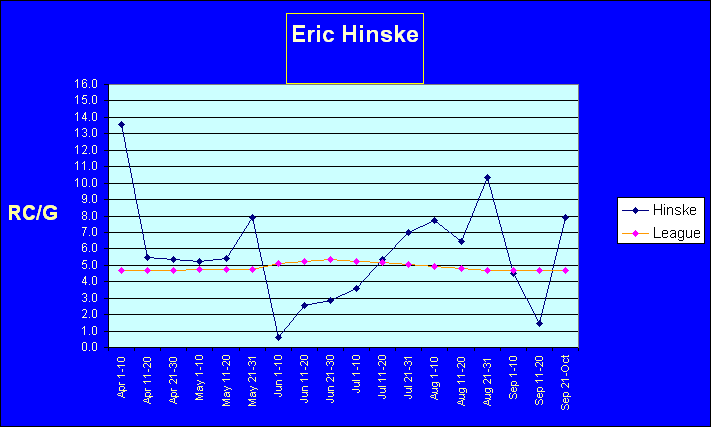
Oh, we all knew this was coming. Even though he was injured and having an off year, Delgado still gave Toronto the fourth best production in the league in 2004. The Jays split the 1B duties, by a ratio of roughly 58-42 per cent, between Hinske and Hillenbrand. Shea proved to be a much better hitter when he was playing 1B than when he was playing 3B. Hinske, on the other hand, was a much more effective hitter when he was DHing than when he was in the field. Hinske had a strange season - twice in the course of the year, his hitting just suddenly and completely fell right off a cliff. He just stopped hitting completely. The first time this happened, it took him several weeks to slowly regain his form. The second time, in September, he bounced right back immediately.
As for Delgado, he created more than 8 runs a game despite playing in a pitcher's park in a new league. He would have given Toronto the best production in the league at 1B, and been worth at least 30 additional runs. Sigh.
SECOND BASE TEAM AB R H TB 2B 3B HR RBI BB SO SB CS SH SF HBP GDP AVG SLG OBP RC RC/27 Baltimore 660 108 202 318 48 7 18 77 76 91 29 10 5 4 4 13 .306 .482 .377 117 6.89 Texas 656 107 177 338 43 2 38 107 37 127 31 2 0 5 8 7 .270 .515 .314 108 6.07 Oakland 608 94 174 266 26 6 18 74 60 77 1 4 4 4 5 14 .286 .438 .351 88 5.47 Detroit 625 88 182 262 35 3 13 69 32 68 9 3 13 7 10 12 .291 .419 .326 84 5.14 LA Angels 566 73 166 216 31 2 5 56 39 94 29 5 5 8 7 8 .293 .382 .339 76 5.11 Chicago 627 87 174 262 29 7 15 75 56 136 20 6 14 6 7 16 .278 .418 .334 86 5.11 New York 640 89 189 289 40 4 14 68 23 87 3 6 12 3 5 19 .295 .452 .318 84 5.02 AVERAGE 610 84 165 252 33 4 15 73 46 101 13 4 7 6 7 14 .271 .414 .323 79 4.78 Tampa Bay 602 80 156 258 29 2 23 94 37 120 2 1 7 6 12 18 .259 .429 .309 74 4.51 Boston 571 92 145 226 36 3 13 63 68 143 7 4 2 6 3 15 .254 .396 .332 71 4.49 Toronto 596 87 158 232 31 5 11 78 46 80 8 2 1 10 6 11 .265 .389 .319 72 4.46 Cleveland 620 75 166 258 39 1 17 81 37 85 6 2 8 6 4 21 .268 .416 .307 73 4.35 Minnesota 586 64 150 202 19 6 7 51 53 109 13 4 11 4 4 14 .256 .345 .315 62 3.85 Seattle 611 64 143 218 38 5 9 69 34 101 15 4 4 4 10 15 .234 .357 .282 58 3.36 KC 566 66 133 189 21 4 9 55 44 100 4 8 11 8 6 10 .235 .334 .288 52 3.26
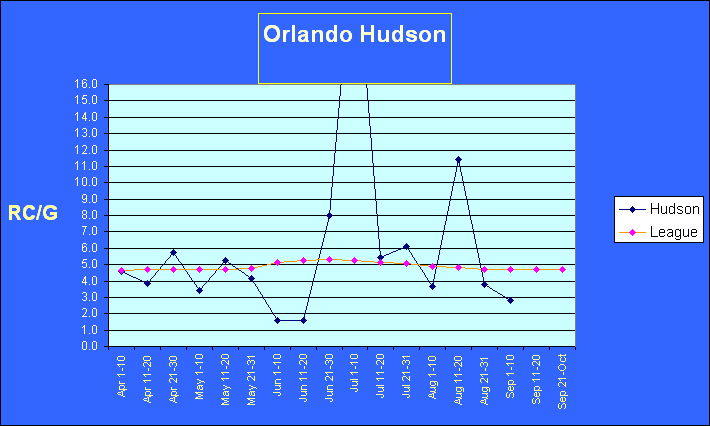
A bit of a step backward here, as Toronto actually had the third best offensive production in the AL out of this position in 2004. Once again, Orlando Hudson and Frank Menechino had most of the at bats. Hudson was solid, but not quite as good with the bat as in 2004. The same applies to Menechino, who actually hit well enough while he was playing 2b - it's just that little Frank had been sensational coming off the bench the year before. In Hudson's case, he didn't have the usual number of spikes in his performance, periods when he got red hot. A further problem was the work of Aaron Hill, who contributed an utterly empty .273 batting average - no walks and no ower - when he was filling in over the final month. The Jays production was down, and the bar had been raised around the league, by Brian Roberts in particular. Oakland and Detroit, in particular, made big upgrades.
THIRD BASE TEAM AB R H TB 2B 3B HR RBI BB SO SB CS SH SF HBP GDP AVG SLG OBP RC RC/27 New York 615 122 195 368 30 1 47 129 88 140 21 6 0 3 16 8 .317 .598 .414 150 9.66 Baltimore 648 91 180 298 32 1 28 91 52 116 7 4 8 3 10 10 .278 .460 .336 97 5.61 Boston 583 78 172 248 40 3 10 70 66 84 1 0 2 5 8 22 .295 .425 .370 85 5.59 Toronto 620 91 175 261 34 2 16 79 65 108 6 2 0 2 12 15 .282 .421 .361 89 5.41 Oakland 633 92 165 283 40 0 26 101 60 133 6 0 1 9 2 11 .261 .447 .322 89 5.15 Tampa Bay 595 81 168 261 38 2 17 79 38 109 2 1 4 5 7 17 .282 .439 .328 80 5.07 Detroit 626 80 166 267 33 10 16 75 65 141 7 7 8 6 3 14 .265 .427 .331 84 4.91 AVERAGE 610 82 163 261 33 3 20 80 54 117 8 4 3 4 7 16 .266 .427 .329 81 4.86 Texas 658 83 172 282 35 0 25 92 51 140 1 0 0 4 4 16 .261 .429 .317 84 4.65 Chicago 575 69 149 248 24 3 23 71 33 79 9 8 2 4 10 11 .259 .431 .308 71 4.50 Seattle 635 73 157 258 37 2 20 91 43 121 5 1 0 4 5 16 .247 .406 .298 72 4.06 LA Angels 610 89 150 237 29 8 14 58 53 132 25 11 6 3 2 11 .246 .389 .304 69 4.06 Minnesota 581 71 149 229 33 4 13 59 51 101 5 11 6 6 4 32 .256 .394 .315 59 3.69 KC 577 71 144 210 34 4 8 60 49 123 10 3 4 1 1 20 .250 .364 .307 59 3.68 Cleveland 585 63 134 201 20 1 15 64 40 116 9 4 6 6 9 17 .229 .344 .283 53 3.18
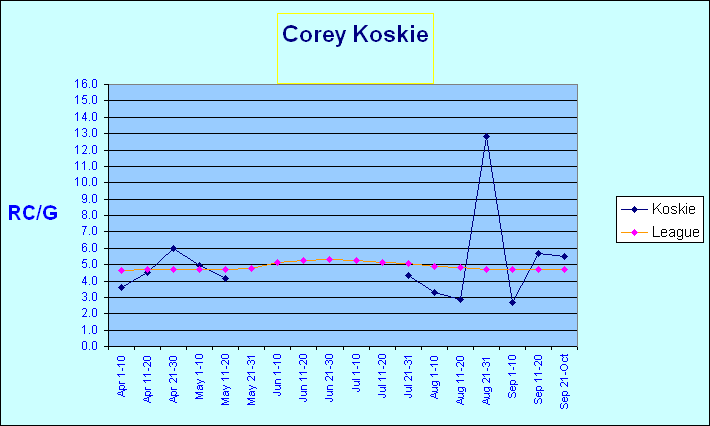
That Alex Rodriguez is one hell of a hitter. Well, we knew that already. What we may not have known, and which should come as a pleasant surprise, is the production Toronto got from their three-headed third baseman. Seriously, who expected Toronto to get more offense out of their third basemen than the teams that employ Eric Chavez, Hank Blalock, and Adrian Beltre? In 2004, thanks to Eric Hinske's poor season, they had ranked 13th in the league. Only half the 2005 at bats went to Corey Koskie, which was not exactly the plan, but it worked out anyway. Koskie hit much, much better (.270, .364, .426) when he was at 3b than when he was the DH. The rest of the playing time was divided between: Shea Hillenbrand, who was adequate, if not quite as good as Koskie when playing third; and Aaron Hill, who was playing here for those first few weeks when he hit the ground running, like the next coming of Paul Molitor.
SHORTSTOP TEAM AB R H TB 2B 3B HR RBI BB SO SB CS SH SF HBP GDP AVG SLG OBP RC RC/27 Texas 682 115 223 347 42 5 24 95 56 93 5 2 0 3 3 22 .327 .509 .379 122 7.16 Baltimore 657 91 201 345 50 5 27 99 41 81 5 1 1 3 7 26 .306 .525 .351 110 6.48 Cleveland 596 90 172 298 39 6 25 84 63 139 1 3 2 5 4 13 .289 .500 .357 101 6.41 New York 676 120 205 297 25 5 19 71 80 122 13 5 8 3 12 16 .303 .439 .381 110 6.29 Tampa Bay 648 95 192 267 39 6 8 65 63 79 39 11 3 4 6 8 .296 .412 .360 97 5.76 Oakland 606 101 161 262 43 6 16 67 64 90 5 1 6 1 1 15 .266 .432 .333 83 5.04 AVERAGE 621 85 171 255 34 5 14 69 50 94 12 4 6 4 6 14 .275 .412 .330 81 4.88 Boston 670 106 182 252 38 4 8 73 58 114 9 4 7 6 3 15 .272 .376 .327 79 4.39 LA Angels 632 76 168 237 35 5 8 69 45 56 26 2 4 2 3 14 .266 .375 .315 74 4.30 Toronto 593 76 147 212 31 5 8 72 62 71 16 2 7 10 6 7 .248 .358 .317 70 4.22 Seattle 555 59 147 204 33 6 4 48 37 88 8 7 5 4 7 12 .265 .368 .314 60 3.99 Chicago 550 65 135 212 23 3 16 74 37 87 9 6 12 10 4 8 .245 .385 .287 60 3.92 KC 629 71 168 233 22 5 11 57 21 111 7 5 10 2 15 13 .267 .370 .301 67 3.91 Detroit 619 67 157 223 28 7 8 39 38 89 9 3 3 0 3 15 .254 .360 .299 62 3.64 Minnesota 575 61 135 187 29 1 7 47 36 96 10 2 11 4 4 9 .235 .325 .278 52 3.20
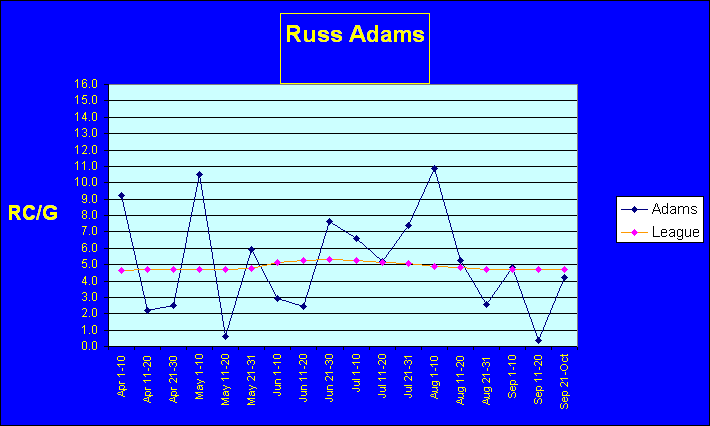
This was an upgrade as well - Toronto shortstops were awful in 2004, better than only Seattle's. It wasn't quite as significant an upgrade as many of us were expecting, mainly because Russ Adams appeared to crash into the Rookie Wall over the last six weeks of the season. You can see it pretty clearly in the graphic. The other shortstops were awful at the plate - John McDonald slapped some singles, but he slugged .321, and Aaron Hill didn't hit at all when he played here (.146 as a shortstop.) Derek Jeter ranks fourth despite yet another fine year, and despite Nomar and A-Rod no longer being around at the position in the AL. The new kids on the block are Michael Young and Jhonny Peralta.
LEFTFIELD TEAM AB R H TB 2B 3B HR RBI BB SO SB CS SH SF HBP GDP AVG SLG OBP RC RC/27 Boston 625 123 179 354 35 1 46 153 84 134 1 0 0 9 10 22 .286 .566 .375 124 7.50 Texas 629 95 169 324 41 6 34 89 61 109 5 2 0 3 5 7 .269 .515 .337 106 6.24 Detroit 627 81 189 316 31 3 30 106 32 109 3 1 1 4 5 15 .301 .504 .338 101 6.20 Cleveland 653 94 197 304 45 4 18 77 55 94 15 7 12 5 0 10 .302 .466 .348 104 6.16 Tampa Bay 681 109 205 319 33 15 17 84 28 106 43 7 6 7 5 12 .301 .468 .327 105 5.95 LA Angels 653 88 194 301 35 3 24 110 37 95 6 5 0 4 1 15 .297 .461 .364 93 5.50 Toronto 632 80 180 265 38 7 11 81 44 98 3 7 5 5 22 11 .285 .419 .347 88 5.23 AVERAGE 635 90 189 297 36 5 20 89 54 107 15 6 5 6 7 14 .278 .437 .332 93 5.20 NY Yankees 646 100 180 266 32 3 16 84 58 84 19 3 3 5 3 11 .279 .412 .337 89 5.15 Seattle 618 84 164 244 37 2 13 70 64 94 14 11 7 4 8 11 .265 .395 .337 78 4.67 Oakland 594 79 147 244 36 2 19 75 52 82 3 4 2 4 11 11 .247 .411 .317 73 4.42 Minnesota 674 82 186 262 35 4 11 69 44 90 9 7 5 6 9 16 .276 .389 .324 80 4.41 KC 613 81 169 243 25 5 13 68 42 90 5 4 2 6 5 21 .276 .396 .323 71 4.34 Chicago 647 96 174 212 30 1 2 38 56 98 58 23 9 7 5 9 .269 .328 .325 70 4.01 Baltimore 598 73 143 228 26 4 17 60 42 114 8 2 7 4 2 11 .239 .381 .286 63 3.76
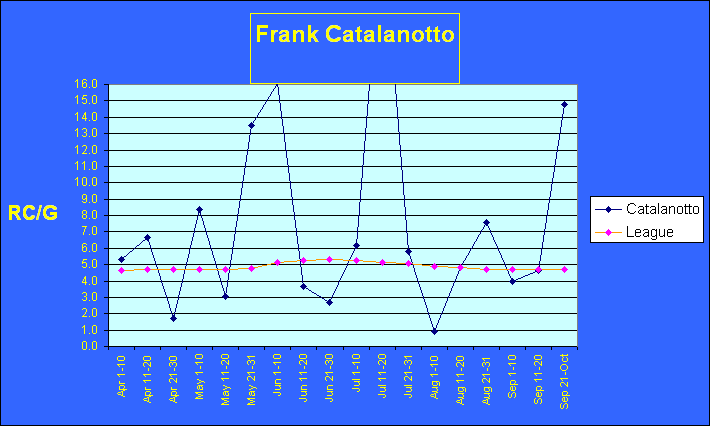
Frank Catalanotto isn't Manny Ramirez, but there are 12 other teams besides Toronto who don't have Manny Ramirez. He's one of a kind, and once more this year he was being Manny. The rest of us have to get by without him somehow. As for Catalanotto, he was healthy in 2005, and had a solid season (and an absolutely mind-boggling final week). In addition, Reed Johnson hit much, much better when he was in LF (.289) than when he was in RF (.225). The Toronto left fielders were awful in 2004, but they were clearly respectable this past season.
CENTRE FIELD TEAM AB R H TB 2B 3B HR RBI BB SO SB CS SH SF HBP GDP AVG SLG OBP RC RC/27 Boston 695 128 220 310 39 6 13 83 57 78 20 1 0 9 4 5 .317 .446 .367 117 6.64 Cleveland 675 115 194 323 38 11 23 83 54 139 23 10 6 2 7 17 .287 .479 .343 104 5.83 KC 641 95 180 272 41 6 14 65 56 111 6 7 7 7 13 12 .281 .424 .344 90 5.26 Toronto 647 80 174 295 31 3 28 98 53 96 9 3 0 8 3 16 .269 .456 .323 90 5.15 Minnesota 631 100 169 267 35 3 19 80 52 109 32 10 1 4 12 17 .268 .423 .333 84 4.92 Chicago 621 81 173 260 32 5 15 73 35 121 20 6 7 4 20 19 .279 .419 .332 82 4.92 AVERAGE 627 87 168 255 33 5 15 72 49 103 18 7 4 5 6 13 .268 .407 .322 79 4.64 Oakland 685 88 185 289 37 2 21 101 44 69 5 6 1 5 1 15 .270 .422 .313 84 4.52 LA Angels 625 82 161 246 31 3 16 67 57 94 27 17 5 4 3 8 .258 .394 .318 75 4.35 Detroit 555 69 144 218 24 7 12 51 38 104 25 7 14 5 2 11 .259 .393 .300 65 4.28 Tampa Bay 592 78 156 232 30 4 13 67 31 112 29 6 5 2 4 13 .264 .392 .301 68 4.21 Baltimore 571 75 149 198 27 2 6 52 43 92 23 12 6 6 10 5 .261 .347 .318 63 4.03 Texas 623 85 150 249 32 8 17 73 53 121 11 2 1 5 0 15 .241 .400 .298 70 4.02 Seattle 599 68 148 204 36 4 4 52 57 92 16 11 4 4 2 12 .247 .341 .311 60 3.58 New York 622 68 151 207 31 2 7 60 50 99 6 4 3 8 1 16 .243 .333 .295 57 3.29
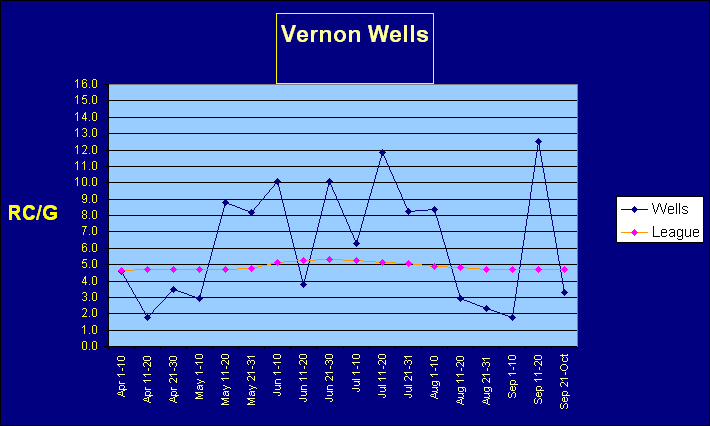
Many Blue Jays fans were disappointed by Vernon Wells 2005 season. Vernon Wells himself was very unhappy with his performance, and bviously what he did this past year doesn't compare to his 2003 campaign. True enough, but he was able to stay in the lineup and give the team superior offensive production at a key defensive position. I've said it many times already - he's a somewhat better version of Joe Carter as a hitter. The fact that he's also a Gold Glove centre fielder... seriously, what's not to like? See the player for what he is, not what someone thinks he ought to be. Among other things, Wells and Sizemore are the only AL centre fielders who can really be regarded as capable power hitters. Elsewhere - what can we say besides "Where have you gone, Joe DiMaggio? "Can't blame it on Womack, who had just 64 ABs as a CF. Williams was bad, and Matsui didn't hit when he was in CF. The Royals did surprisingly well without Carlos Beltran - David DeJesus had a productive year, and Aaron Guiel was very good indeed towards the end.
RIGHT FIELD TEAM AB R H TB 2B 3B HR RBI BB SO SB CS SH SF HBP GDP AVG SLG OBP RC RC/27 LA Angels 622 110 195 331 33 4 35 122 64 60 17 5 3 5 8 18 .314 .532 .380 120 7.56 New York 625 105 174 299 27 1 32 117 76 84 11 2 0 6 9 11 .278 .478 .362 106 6.33 KC 603 86 172 281 38 4 21 98 53 113 10 2 2 7 7 16 .285 .466 .345 93 5.80 Chicago 615 83 168 311 34 2 35 100 43 112 11 5 2 2 9 15 .273 .506 .328 95 5.74 Seattle 682 110 202 290 21 11 15 65 49 67 33 8 2 6 4 5 .296 .425 .343 101 5.70 Tampa Bay 624 86 175 281 25 6 24 83 50 119 12 8 2 6 9 10 .280 .450 .339 91 5.48 Oakland 596 86 158 276 38 1 26 94 59 129 2 1 1 2 5 13 .265 .463 .335 87 5.39 Boston 594 92 163 256 43 1 16 89 61 85 2 2 1 9 4 10 .274 .431 .341 85 5.31 AVERAGE 615 89 167 278 32 4 24 89 54 106 10 4 1 5 7 13 .272 .451 .333 88 5.30 Baltimore 619 71 167 295 35 3 29 89 37 107 3 0 1 2 5 19 .270 .477 .315 85 5.10 Detroit 620 73 172 255 29 3 16 87 54 90 4 2 0 13 3 14 .277 .411 .332 81 4.91 Minnesota 606 75 153 258 28 4 23 81 58 131 13 6 2 5 7 19 .252 .426 .322 76 4.56 Cleveland 586 80 138 247 36 2 23 61 55 133 3 6 2 5 10 9 .235 .422 .309 72 4.34 Texas 597 93 140 258 25 0 31 88 56 125 5 4 0 3 5 12 .235 .432 .304 73 4.34 Toronto 625 91 163 248 29 10 12 76 35 133 14 11 0 4 9 14 .261 .397 .308 70 4.07
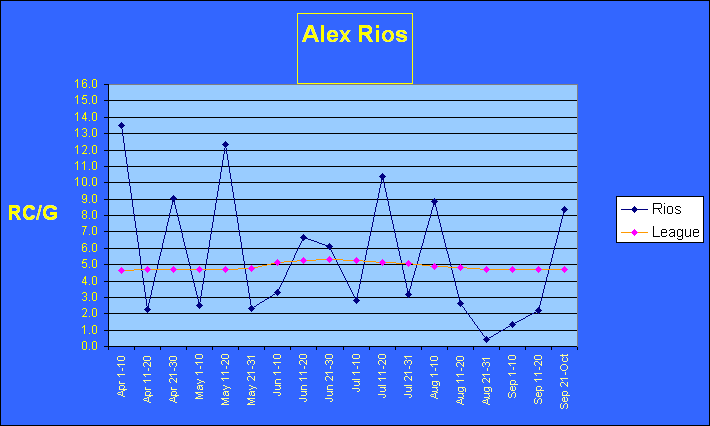
Ouch. This was not good at all. Alex Rios hit 10 times as many HRs as did in his rookie year, but he lost 20 points in batting average. He's been streaky as hell, going up and down like a yoyo until a month-long stretch towards the end of the season when he was consistently awful. Meanwhile, Reed Johnson didn't hit a lick when he was in right field. It all added up to regression. You know, Gabe Gross may yet have a future with this team...
DH TEAM AB R H TB 2B 3B HR RBI BB SO SB CS SH SF HBP GDP AVG SLG OBP RC RC/27 Boston 580 115 171 344 40 1 44 146 102 123 1 0 0 9 1 13 .295 .593 .396 132 8.70 Cleveland 573 102 167 323 45 0 37 115 83 146 0 0 0 4 9 9 .291 .564 .387 122 8.08 Detroit 535 80 163 287 37 3 27 83 39 138 1 1 0 1 7 12 .305 .536 .359 97 7.04 Tampa Bay 558 80 148 258 38 3 22 94 56 138 11 4 1 10 15 16 .265 .462 .342 84 5.52 KC 552 78 146 249 36 2 21 82 69 103 2 1 1 8 4 15 .264 .451 .345 82 5.43 AVERAGE 566 81 148 252 30 2 23 88 64 118 4 2 1 5 6 15 .261 .445 .339 80 5.19 Toronto 551 82 150 238 44 4 12 64 49 110 2 3 3 3 16 15 .272 .432 .346 77 5.17 New York 574 78 141 247 19 0 29 108 85 114 0 1 0 4 11 15 .246 .430 .352 82 5.09 Chicago 579 75 141 268 25 2 33 107 56 122 4 5 0 12 5 13 .244 .463 .310 78 4.81 Texas 579 97 141 247 20 4 26 69 71 151 4 3 1 3 5 17 .244 .427 .329 75 4.63 Minnesota 575 67 146 225 18 5 17 73 59 123 6 1 1 3 8 9 .254 .391 .330 72 4.55 Seattle 572 71 153 221 22 2 14 80 56 95 7 1 2 3 2 13 .267 .386 .332 71 4.54 LA Angels 574 75 147 219 26 2 14 66 53 99 15 5 4 6 1 20 .256 .382 .315 64 4.05 Oakland 567 69 139 199 23 2 11 71 62 84 1 0 3 1 3 21 .245 .351 .321 58 3.66 Baltimore 559 62 117 202 27 2 18 70 54 101 2 3 1 6 0 22 .209 .361 .276 49 2.97
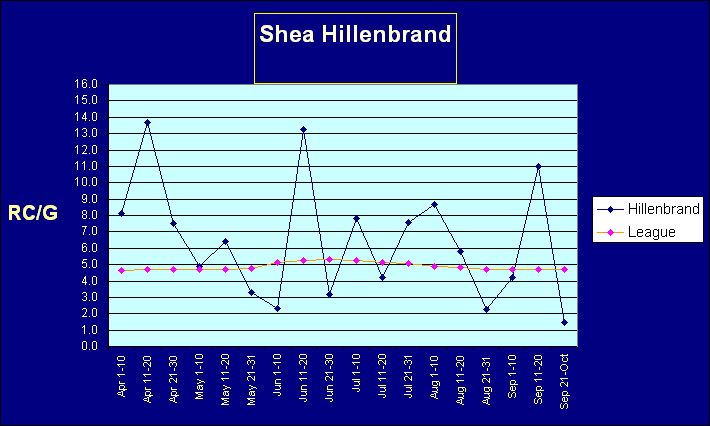
Yes, the Baltimore DHs were really that bad - they mainly shuffled Gibbons, Sosa, and Lopez through the spot - all three hit much better when they were also playing the field. Toronto DHs were awful in 2004, but this is the easiest position of all to find someone who can help. The Jays didn't have a regular DH - three men (Hillenbrand, Hill, and Hinske) had between 104 and 128 at bats. Two of the three were pretty good - Shea Hillenbrand early, and Eric Hinske late. Hinske was actually the best DH on the team (.308, .400, .442), by a nose over Hillenbrand. Hill was OK - the guys dragging down the numbers were Frank Menechino and, especially, Corey Koskie. Koskie went 11-69 (.159) as the DH. And so a lesson is learned: if Koskie needs a day off, you might as well just give him the day off.
The obvious places where Toronto urgently needs to upgrade are right field. And backup catcher - the Jays secondary catchers were awful, and Zaun pretty clearly wore down because there was no useful alternative. Granted, there's room for improvement pretty much everywhere - but those two spots were the real glaring problem areas in 2005.
I suppose we knew that already?
Our bonus graphic is Aaron Hill's rookie season:

Hill wasn't expected to arrive in the majors as soon as he did, and many of us were surprised when he was summoned after Koskie's injury. The Paul Molitor impression Hill performed for the AL during his first month in the big leagues has resulted in his being cut an awful lot of slack, both by people connected with the team as well as the fan base (as represented by you, gentle readers!) So it's my grim duty to remind you that the first nine guys I made pretty pictures for were all - every one of them, even Alex Rios - more productive hitters than Aaron Hill in 2005.
Think of Rios one year ago - that's where Hill is now. His first year showed off a pretty decent batting average, and pretty well nothing else. He's got some work to do, and Toronto fans will be hoping that he makes more progress in 2006 than Rios did in 2005.
But there are no guarantees.
https://www.battersbox.ca/article.php?story=20051007021812859